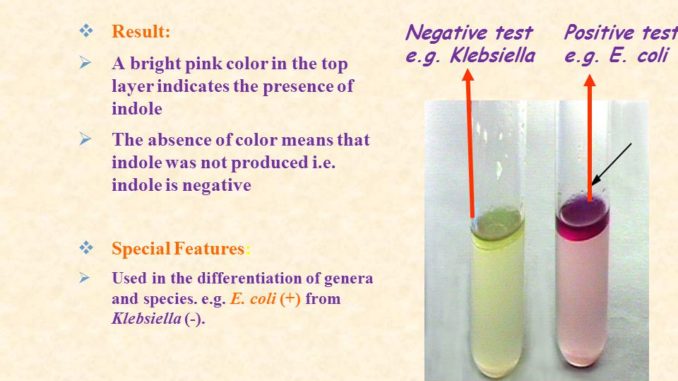
Indole test:
Objective:
- to detect the ability of organism to produce enzyme tryptophanase.
Principle:
- Indole test is a biochemical test which differentiates the coliform from other members of Enterobacteriacee by detecting their ability to produce the enzyme tryptophanase. This enzyme hydrolyses the amino acid tryptophan into indole, pyruvic acid and ammonia. It is the intracellular enzyme (endoenzyme).
Tryptophan + H2O————tryptophanase enzyme——> Indole + Pyruvic acid + Ammonia
- Pyruvic acid can then be used by the organism in the Kreb’s cycle or it can enter glycolysis and be used to synthesize other compounds necessary for the cell. The media that is used for indole test is SIM (sulphide, indole, motility) medium or nutrient peptone, both of those media provides sufficient amino acid, tryptophan which acts as substrate for the above reaction. Hence, the organism that are able to produce the pyruvic acid as main product and indole, ammonia as the byproduct. The reagent used for this test is kovac’s reagent; (HCI and dimenthyl aminobenzaldehyde dissolved in amyl alcohol) which reacts with the side product of the tryptophan catabolism reaction i.e indole to form Rosindole dye which is cherry red in colour.
- Hence the formation of cherry red colour of Rosindole dye indicates positive indole test, otherwise not Escherichia coli is positive to indole test while klebsiella is negative to it.
Requirements:
- Peptone broth ( a nutrient enriched with Amino acid tryptophan)
- Bacterial sample (Escherichia coli and Klebsiella spp)
- Kovac’s reagent
Procedure:
- Prepare peptone broth or SIM media in test tubes and the tubes were autoclaved at 15 lbs/inch2 pressure for 15 mins.
- using sterile wire, inoculate the broth with the given samples of organism and label the tubes with name of organism
- Incubate the tubes at 37°C for 24-48 hours.
- After proper incubation, add 4-8 drops of kovac’s reagent to the tube touching the wall of glass tube
- Roll each tube between your palms to mix the reagent through the culture.
- Let stand for a while and observe for the development of cherry red color at the surface of media.
Result:

- Indole test positive: cherry red color ( E. coli)
- Indole test negative: no red color ( Klebsiella)
